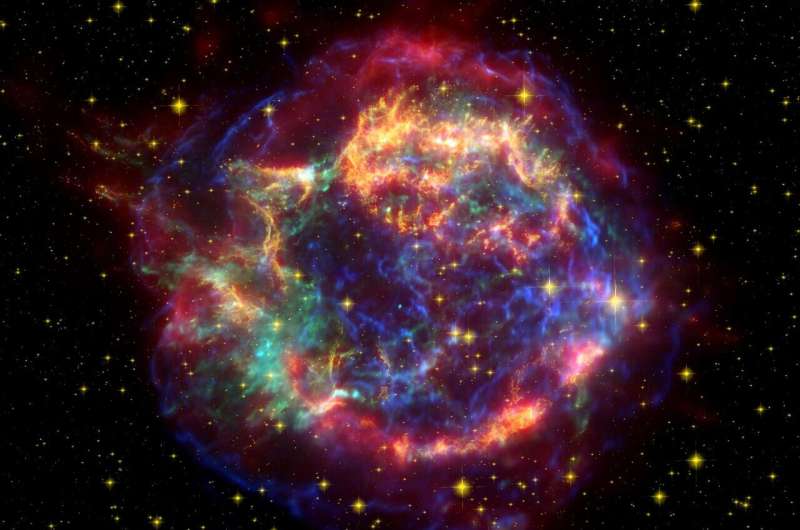
Copernical Team
WVU space robotics research helps Mars rovers find their footing
 West Virginia University scientists have developed a way for extraplanetary rovers to use nonvisual information to maneuver over treacherous terrain. This research aims to prevent losses like that of the Martian exploration rover Spirit, which ceased communications after its wheels became trapped in invisibly shifting sands in 2010.
Space roboticist Cagri Kilic, a Statler College of Engine
West Virginia University scientists have developed a way for extraplanetary rovers to use nonvisual information to maneuver over treacherous terrain. This research aims to prevent losses like that of the Martian exploration rover Spirit, which ceased communications after its wheels became trapped in invisibly shifting sands in 2010.
Space roboticist Cagri Kilic, a Statler College of Engine Artemis I to launch first-of-a-kind deep space biology mission
 Poised to launch on Artemis I from NASA's Kennedy Space Center in Florida, BioSentinel - a shoebox-sized CubeSat - will perform the first long-duration biology experiment in deep space. Artemis missions at the Moon will prepare humans to travel on increasingly farther and longer-duration missions to destinations like Mars, and BioSentinel will carry microorganisms, in the form of yeast, to fill
Poised to launch on Artemis I from NASA's Kennedy Space Center in Florida, BioSentinel - a shoebox-sized CubeSat - will perform the first long-duration biology experiment in deep space. Artemis missions at the Moon will prepare humans to travel on increasingly farther and longer-duration missions to destinations like Mars, and BioSentinel will carry microorganisms, in the form of yeast, to fill Europe Ready For Artemis
 Video:
00:03:26
Video:
00:03:26
ESA and NASA are working hand in hand before the first Artemis mission to the Moon through a series of joint mission simulations. Teams based at the Erasmus Support Facility (ESF) at ESA’s ESTEC facility in The Netherlands, the German Space Operations Centre at ESA’s Columbus Control Centre in Oberphfaffenhofen and NASA’s Johnson Space Center in Houston are combining their expertise in a series of exercises to ensure a successful launch.
When it comes to simulations, it’s important that not everything goes perfectly right as it recreates - in real time - different stages of the mission to
Want to colonize Mars? Talk to this outer space anthropologist first

Maybe infinity and beyond should wait.
Prominent physicists and wealthy tycoons envision life scattered across the solar system. Elon Musk wants humans to become a multiplanetary species. Jeff Bezos pictures floating space colonies home to billions.
Simulated-gravity ecosystems powered by the sun.
Rocket launch to image supernova remnant

A Northwestern University astrophysics team is aiming for the stars—well, a dead star, that is.
On Aug. 21, the NASA-funded team will launch its "Micro-X" rocket from White Sands Missile Range in southern New Mexico. The rocket will spend 15 minutes in space—just enough time to snap a quick image of supernova remnant Cassiopeia A, a star in the Cassiopeia constellation that exploded approximately 11,000 light-years away from Earth. Then, the rocket will parachute back to Earth, landing in the desert—about 45 miles from the launchpad—where the Northwestern team will recover its payload.
Short for "high-resolution microcalorimeter X-ray imaging rocket," the Micro-X rocket will carry a superconductor-based X-ray imaging spectrometer that is capable of measuring the energy of each incoming X-ray from astronomical sources with unprecedented accuracy.
"The supernova remnant is so hot that most of the light it emits is not in the visible range," said Northwestern's Enectali Figueroa-Feliciano, who leads the project. "We have to use X-ray imaging, which isn't possible from Earth because our atmosphere absorbs X-rays. That's why we have to go into space.
J-Space partners with Virgin Orbit to bring sovereign air-launch capability to South Korea
 Virgin Orbit (Nasdaq: VORB), a leading launch provider, announced it has signed an agreement with South Korean investment group J-Space. The agreement will allow the companies to assess candidate spaceport launch sites in South Korea, with the goal of providing satellite launch services from there using Virgin Orbit's LauncherOne System.
The cooperative effort is designed to act as a catal
Virgin Orbit (Nasdaq: VORB), a leading launch provider, announced it has signed an agreement with South Korean investment group J-Space. The agreement will allow the companies to assess candidate spaceport launch sites in South Korea, with the goal of providing satellite launch services from there using Virgin Orbit's LauncherOne System.
The cooperative effort is designed to act as a catal RocketStar set to launch TriSept satellite security solution aboard experimental payloads
 TriSept Corporation, a leading provider of launch integration and mission management services, has completed the integration of two experimental mission payloads running its new TSEL satellite security operating software for a suborbital test flight aboard RocketStar's launch vehicle set to liftoff from the Koehn Lake Bed in the Mojave Desert.
TriSept has teamed with RocketStar and its 40-
TriSept Corporation, a leading provider of launch integration and mission management services, has completed the integration of two experimental mission payloads running its new TSEL satellite security operating software for a suborbital test flight aboard RocketStar's launch vehicle set to liftoff from the Koehn Lake Bed in the Mojave Desert.
TriSept has teamed with RocketStar and its 40- Maxar to build 14 space platforms for L3Harris to support SDA's Tranche 1 Tracking Layer Program
 Maxar Technologies (NYSE:MAXR) (TSX:MAXR), provider of comprehensive space solutions and secure, precise, geospatial intelligence, has announced it has been selected by L3Harris Technologies for the design and production of 14 spacecraft platforms and associated support for its Tranche 1 Tracking Layer contract with the Space Development Agency (SDA).
SDA selected L3Harris as a prime for i
Maxar Technologies (NYSE:MAXR) (TSX:MAXR), provider of comprehensive space solutions and secure, precise, geospatial intelligence, has announced it has been selected by L3Harris Technologies for the design and production of 14 spacecraft platforms and associated support for its Tranche 1 Tracking Layer contract with the Space Development Agency (SDA).
SDA selected L3Harris as a prime for i M2 satellite delivers Australia's first high-res Earth observation images
 A UNSW Canberra Space satellite mission, known as M2, is now delivering Australia's first high-resolution remote sensing image of the Earth. UNSW Canberra Space Director Professor Russell Boyce said the capture of the image is an important step forward for Australia's sovereign space capabilities, with the same mission also successfully collecting and transmitting commercial aviation identificat
A UNSW Canberra Space satellite mission, known as M2, is now delivering Australia's first high-resolution remote sensing image of the Earth. UNSW Canberra Space Director Professor Russell Boyce said the capture of the image is an important step forward for Australia's sovereign space capabilities, with the same mission also successfully collecting and transmitting commercial aviation identificat Scientists detect newborn planet that could be forming moons
 For the first time, scientists have discovered what appears to be a brand new planet, 395 light-years from Earth, that could be forming moons.
Scientists using the Atacama Large Millimeter/submillimeter Array, or ALMA, recently detected gas in a circumplanetary disk, the third one ever discovered.
Circumplanetary disks are comprised of gas, dust and debris around young planets th
For the first time, scientists have discovered what appears to be a brand new planet, 395 light-years from Earth, that could be forming moons.
Scientists using the Atacama Large Millimeter/submillimeter Array, or ALMA, recently detected gas in a circumplanetary disk, the third one ever discovered.
Circumplanetary disks are comprised of gas, dust and debris around young planets th 